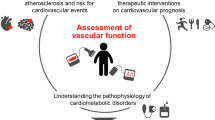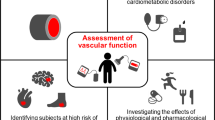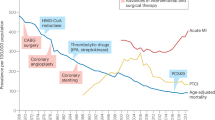Abstract
Current guidance around the prevention of cardiovascular events is based on long-term risk, typically calculated over 10 years. A growing body of evidence, however, suggests that vascular risk fluctuates greatly over much shorter time periods. We suggest a new paradigm for cardiovascular risk management that is based on targeting interventions during periods of enhanced risk. During such high-risk time windows, prophylactic therapy could have a disproportionately large absolute benefit, altering the risk–benefit balance and cost-effectiveness of available treatments. Major surgery is an example of an exposure known to lead to a transient increase in vascular risk. Emerging evidence supports the usefulness of short-term preventative interventions in the perioperative period. Influenza infection is another exposure known to increase the risk of vascular events, and cardiovascular mortality and morbidity are likely to be major features associated with pandemic influenza. Important questions remain, however, before preventative interventions can be offered as a routine part of influenza management.
This is a preview of subscription content, access via your institution
Access options
Subscribe to this journal
Receive 12 print issues and online access
$189.00 per year
only $15.75 per issue
Buy this article
- Purchase on SpringerLink
- Instant access to full article PDF
Prices may be subject to local taxes which are calculated during checkout

Similar content being viewed by others
References
Grundy, S. M. et al. Implications of recent clinical trials for the National Cholesterol Education Program Adult Treatment Panel III Guidelines. J. Am. Coll. Cardiol. 44, 720–732 (2004).
National Institute for Health and Clinical Excellence. Statins for the prevention of cardiovascular events. National Institute for Health and Clinical Excellence [online], (2006).
Smeeth, L. et al. Risk of myocardial infarction and stroke after acute infection or vaccination. N. Engl. J. Med. 351, 2611–2618 (2004).
Warren-Gash, C., Smeeth, L. & Hayward, A. C. Influenza as a trigger for acute myocardial infarction or death from cardiovascular disease: a systematic review. Lancet Infect. Dis. 9, 601–610 (2009).
Madjid, M. & Casscells, S. W. Of birds and men: cardiologists' role in influenza pandemics. Lancet 364, 1309 (2004).
Devereaux, P. J. et al. Perioperative cardiac events in patients undergoing noncardiac surgery: a review of the magnitude of the problem, the pathophysiology of the events and methods to estimate and communicate risk. CMAJ 173, 627–634 (2005).
Tonetti, M. S. et al. Treatment of periodontitis and endothelial function. N. Engl. J. Med. 356, 911–920 (2007).
Bhaskaran, K. et al. Effects of air pollution on the incidence of myocardial infarction. Heart 95, 1746–1759 (2009).
Bhaskaran, K. et al. Effects of ambient temperature on the incidence of myocardial infarction. Heart 95, 1760–1769 (2009).
Mittleman, M. A. et al. Triggering of acute myocardial infarction by heavy physical exertion. Protection against triggering by regular exertion. Determinants of Myocardial Infarction Onset Study Investigators. N. Engl. J. Med. 329, 1677–1683 (1993).
Wilbert-Lampen, U. et al. Cardiovascular events during World Cup soccer. N. Engl. J. Med. 358, 475–483 (2008).
Heart Protection Study Collaborative Group. MRC/BHF Heart Protection Study of cholesterol lowering with simvastatin in 20,536 high-risk individuals: a randomised placebo-controlled trial. Lancet 360, 7–22 (2002).
Baigent, C. et al. Efficacy and safety of cholesterol-lowering treatment: prospective meta-analysis of data from 90,056 participants in 14 randomised trials of statins. Lancet 366, 1267–1278 (2005).
National Institute for Health and Clinical Excellence. Reducing the risk of venous thromboembolism (deep vein thrombosis and pulmonary embolism) in patients admitted to hospital. National Institute for Health and Clinical Excellence [online], (2010).
Laufs, U. et al. Rapid effects on vascular function after initiation and withdrawal of atorvastatin in healthy, normocholesterolemic men. Am. J. Cardiol. 88, 1306–1307 (2001).
Li, J. J., Fang, C. H., Qian, H. Y. & Hu, W. L. Time course of rapid C-reactive protein reduction by pravastatin in patients with stable angina. Angiology 57, 1–7 (2006).
Hulten, E., Jackson, J. L., Douglas, K., George, S. & Villines, T. C. The effect of early, intensive statin therapy on acute coronary syndrome: a meta-analysis of randomized controlled trials. Arch. Intern. Med. 166, 1814–1821 (2006).
Antithrombotic Trialists' (ATT) Collaboration. Aspirin in the primary and secondary prevention of vascular disease: collaborative meta-analysis of individual participant data from randomised trials. Lancet 373, 1849–1860 (2009).
Ho, P. M. et al. Incidence of death and acute myocardial infarction associated with stopping clopidogrel after acute coronary syndrome. JAMA 299, 532–539 (2008).
Montalescot, G. et al. Prasugrel compared with clopidogrel in patients undergoing percutaneous coronary intervention for ST-elevation myocardial infarction (TRITON-TIMI 38): double-blind, randomised controlled trial. Lancet 373, 723–731 (2009).
Wallentin, L. et al. Ticagrelor versus clopidogrel in patients with acute coronary syndromes. N. Engl. J. Med. 361, 1045–1057 (2009).
Law, M. R., Morris, J. K. & Wald, N. J. Use of blood pressure lowering drugs in the prevention of cardiovascular disease: meta-analysis of 147 randomised trials in the context of expectations from prospective epidemiological studies. BMJ 338, b1665 (2009).
Mega, J. L. et al. Rivaroxaban versus placebo in patients with acute coronary syndromes (ATLAS ACS-TIMI 46): a randomised, double-blind, phase II trial. Lancet 374, 29–38 (2009).
Connolly, S. J. et al. Dabigatran versus warfarin in patients with atrial fibrillation. N. Engl. J. Med. 361, 1139–1151 (2009).
Murry, C. E., Jennings, R. B. & Reimer, K. A. Preconditioning with ischemia: a delay of lethal cell injury in ischemic myocardium. Circulation 74, 1124–1136 (1986).
Hausenloy, D. J. et al. Effect of remote ischaemic preconditioning on myocardial injury in patients undergoing coronary artery bypass graft surgery: a randomised controlled trial. Lancet 370, 575–579 (2007).
Shaw, E., Tofler, G. H., Buckley, T., Bajorek, B. & Ward, M. Therapy for triggered acute risk prevention: a study of feasibility. Heart Lung Circ. 18, 347–352 (2009).
Kapoor, A. S., Kanji, H., Buckingham, J., Devereaux, P. J. & McAlister, F. A. Strength of evidence for perioperative use of statins to reduce cardiovascular risk: systematic review of controlled studies. BMJ 333, 1149 (2006).
Dunkelgrun, M. et al. Bisoprolol and fluvastatin for the reduction of perioperative cardiac mortality and myocardial infarction in intermediate-risk patients undergoing noncardiovascular surgery: a randomized controlled trial (DECREASE-IV). Ann. Surg. 249, 921–926 (2009).
Schouten, O. et al. Fluvastatin and perioperative events in patients undergoing vascular surgery. N. Engl. J. Med. 361, 980–989 (2009).
POISE Study Group. Effects of extended-release metoprolol succinate in patients undergoing non-cardiac surgery (POISE trial): a randomised controlled trial. Lancet 371, 1839–1847 (2008).
Bangalore, S. et al. Perioperative beta blockers in patients having non-cardiac surgery: a meta-analysis. Lancet 372, 1962–1976 (2008).
Acknowledgements
Patrick Vallance contributed to discussions and Raymond Macallister provided useful comments on an earlier draft of the article. L. Smeeth is supported by a senior clinical fellowship from the Wellcome Trust (082178) and A. D. Hingorani is supported by a senior fellowship from the British Heart Foundation. The funders played no role in the preparation and content of the article.
Author information
Authors and Affiliations
Corresponding author
Ethics declarations
Competing interests
The authors declare no competing financial interests.
Rights and permissions
About this article
Cite this article
Smeeth, L., Hingorani, A. Short-term vascular risk: time to take notice?. Nat Rev Cardiol 7, 409–411 (2010). https://doi.org/10.1038/nrcardio.2010.64
Published:
Issue date:
DOI: https://doi.org/10.1038/nrcardio.2010.64



